Money, Banking & Finance: NPV, YTM, Financial Intermediaries - APC312
VerifiedAdded on 2023/06/14
|14
|4288
|160
Report
AI Summary
This report delves into various aspects of finance, banking, and monetary policy. It begins with a practical application of Net Present Value (NPV) and Internal Rate of Return (IRR) calculations for Livingstone Thompson Ltd., providing a recommendation based on the results. The report then explains how Yield to Maturity (YTM) is used to calculate the yield curve and its significance for investors. A critical analysis of the role of financial intermediaries in a well-functioning financial system is presented, highlighting their advantages and disadvantages. Finally, the report discusses the factors that determine the time lag between the implementation of monetary policy instruments and the achievement of ultimate goals. The report concludes by emphasizing the importance of understanding these concepts for effective financial decision-making.

Money banking and
finance
finance
Paraphrase This Document
Need a fresh take? Get an instant paraphrase of this document with our AI Paraphraser
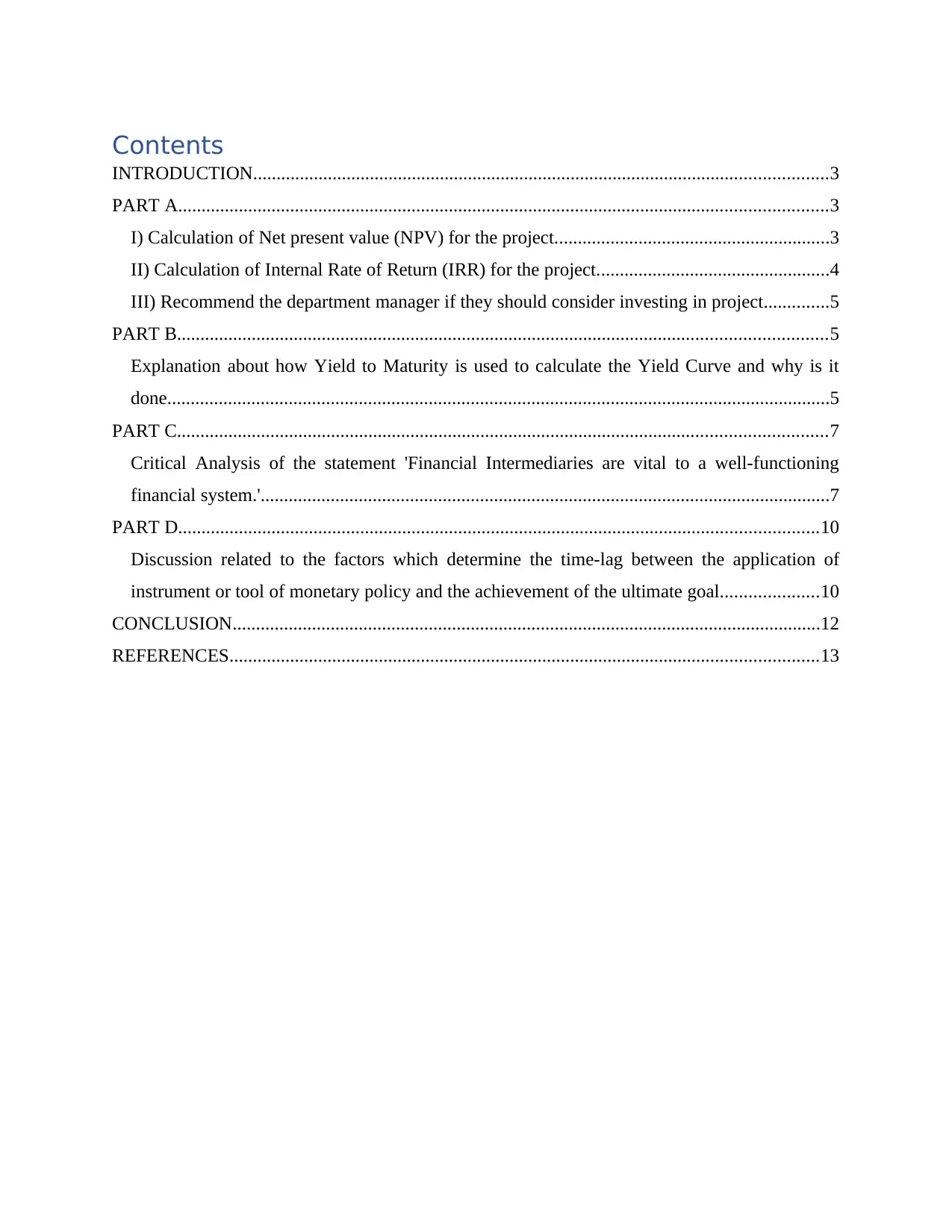
Contents
INTRODUCTION...........................................................................................................................3
PART A...........................................................................................................................................3
I) Calculation of Net present value (NPV) for the project...........................................................3
II) Calculation of Internal Rate of Return (IRR) for the project..................................................4
III) Recommend the department manager if they should consider investing in project..............5
PART B...........................................................................................................................................5
Explanation about how Yield to Maturity is used to calculate the Yield Curve and why is it
done..............................................................................................................................................5
PART C...........................................................................................................................................7
Critical Analysis of the statement 'Financial Intermediaries are vital to a well-functioning
financial system.'..........................................................................................................................7
PART D.........................................................................................................................................10
Discussion related to the factors which determine the time-lag between the application of
instrument or tool of monetary policy and the achievement of the ultimate goal.....................10
CONCLUSION..............................................................................................................................12
REFERENCES..............................................................................................................................13
INTRODUCTION...........................................................................................................................3
PART A...........................................................................................................................................3
I) Calculation of Net present value (NPV) for the project...........................................................3
II) Calculation of Internal Rate of Return (IRR) for the project..................................................4
III) Recommend the department manager if they should consider investing in project..............5
PART B...........................................................................................................................................5
Explanation about how Yield to Maturity is used to calculate the Yield Curve and why is it
done..............................................................................................................................................5
PART C...........................................................................................................................................7
Critical Analysis of the statement 'Financial Intermediaries are vital to a well-functioning
financial system.'..........................................................................................................................7
PART D.........................................................................................................................................10
Discussion related to the factors which determine the time-lag between the application of
instrument or tool of monetary policy and the achievement of the ultimate goal.....................10
CONCLUSION..............................................................................................................................12
REFERENCES..............................................................................................................................13
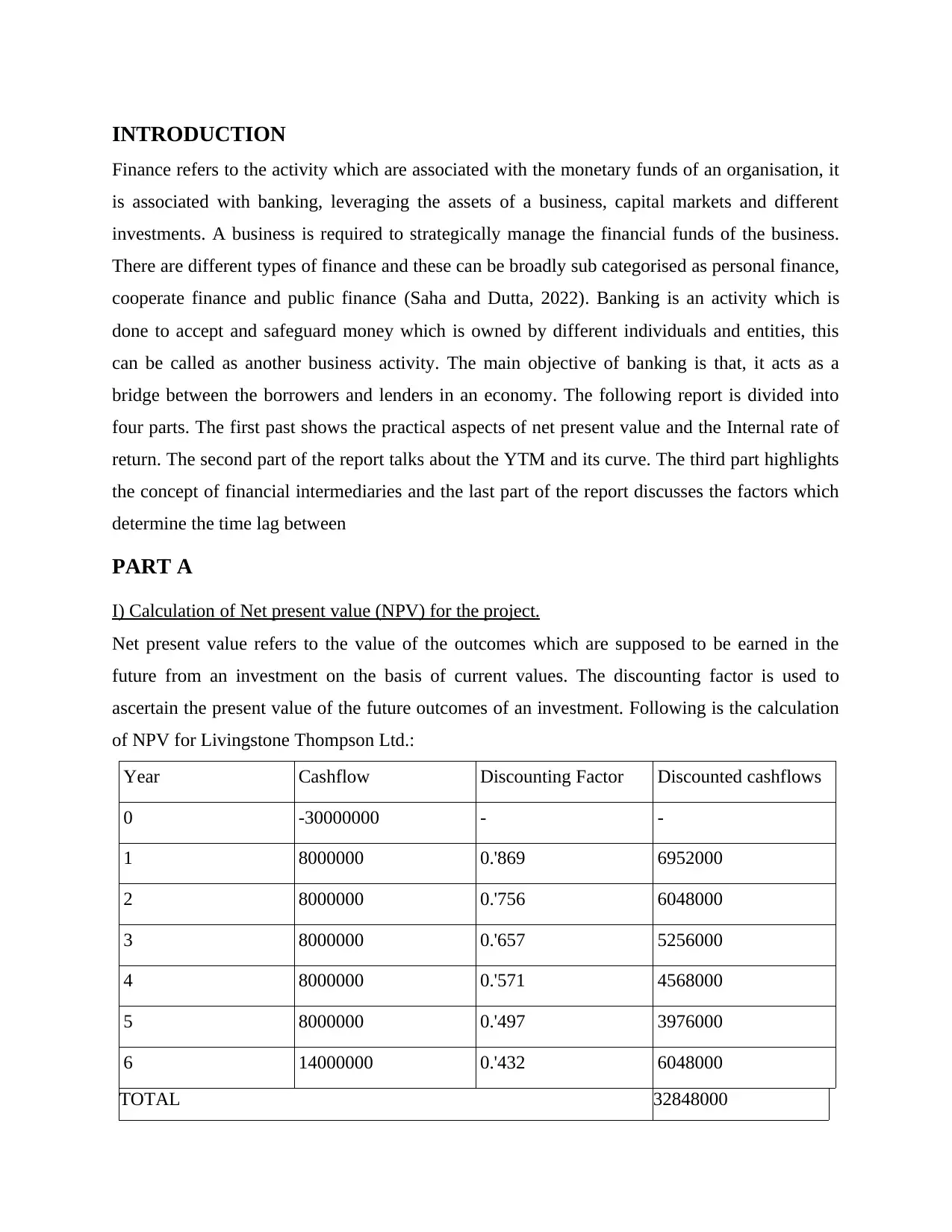
INTRODUCTION
Finance refers to the activity which are associated with the monetary funds of an organisation, it
is associated with banking, leveraging the assets of a business, capital markets and different
investments. A business is required to strategically manage the financial funds of the business.
There are different types of finance and these can be broadly sub categorised as personal finance,
cooperate finance and public finance (Saha and Dutta, 2022). Banking is an activity which is
done to accept and safeguard money which is owned by different individuals and entities, this
can be called as another business activity. The main objective of banking is that, it acts as a
bridge between the borrowers and lenders in an economy. The following report is divided into
four parts. The first past shows the practical aspects of net present value and the Internal rate of
return. The second part of the report talks about the YTM and its curve. The third part highlights
the concept of financial intermediaries and the last part of the report discusses the factors which
determine the time lag between
PART A
I) Calculation of Net present value (NPV) for the project.
Net present value refers to the value of the outcomes which are supposed to be earned in the
future from an investment on the basis of current values. The discounting factor is used to
ascertain the present value of the future outcomes of an investment. Following is the calculation
of NPV for Livingstone Thompson Ltd.:
Year Cashflow Discounting Factor Discounted cashflows
0 -30000000 - -
1 8000000 0.'869 6952000
2 8000000 0.'756 6048000
3 8000000 0.'657 5256000
4 8000000 0.'571 4568000
5 8000000 0.'497 3976000
6 14000000 0.'432 6048000
TOTAL 32848000
Finance refers to the activity which are associated with the monetary funds of an organisation, it
is associated with banking, leveraging the assets of a business, capital markets and different
investments. A business is required to strategically manage the financial funds of the business.
There are different types of finance and these can be broadly sub categorised as personal finance,
cooperate finance and public finance (Saha and Dutta, 2022). Banking is an activity which is
done to accept and safeguard money which is owned by different individuals and entities, this
can be called as another business activity. The main objective of banking is that, it acts as a
bridge between the borrowers and lenders in an economy. The following report is divided into
four parts. The first past shows the practical aspects of net present value and the Internal rate of
return. The second part of the report talks about the YTM and its curve. The third part highlights
the concept of financial intermediaries and the last part of the report discusses the factors which
determine the time lag between
PART A
I) Calculation of Net present value (NPV) for the project.
Net present value refers to the value of the outcomes which are supposed to be earned in the
future from an investment on the basis of current values. The discounting factor is used to
ascertain the present value of the future outcomes of an investment. Following is the calculation
of NPV for Livingstone Thompson Ltd.:
Year Cashflow Discounting Factor Discounted cashflows
0 -30000000 - -
1 8000000 0.'869 6952000
2 8000000 0.'756 6048000
3 8000000 0.'657 5256000
4 8000000 0.'571 4568000
5 8000000 0.'497 3976000
6 14000000 0.'432 6048000
TOTAL 32848000
⊘ This is a preview!⊘
Do you want full access?
Subscribe today to unlock all pages.

Trusted by 1+ million students worldwide

Net Present Value = Present value of cash Inflow – Cash Outflow
= 32848000 – 30000000
= 2,848,000
II) Calculation of Internal Rate of Return (IRR) for the project.
Internal rate of return is a tool used in the financial analysis which estimates the profitability of
the future investments (Quang Trinh, 2022). It makes the NPV of the cash flows zero. Following
is the calculation of IRR for Livingstone Thompson Ltd. Using the hit and trial method:
Taking the discounting rate as 13%
Year Cashflow Discounting Factor Discounted cashflows
0 -30000000 1 -30000000
1 8000000 0.'885 7080000
2 8000000 0.'783 6264000
3 8000000 0.'693 5544000
4 8000000 0.'613 4904000
5 8000000 0.'543 4344000
6 14000000 0.'480 6720000
Net Present Value 4856000
Taking the discounting rate as 20%
Year Cashflow Discounting Factor Discounted cashflows
0 -30000000 1 -30000000
1 8000000 0.'833 6664000
2 8000000 0.'694 5552000
3 8000000 0.'579 4632000
4 8000000 0.'482 3856000
5 8000000 0.'402 3216000
= 32848000 – 30000000
= 2,848,000
II) Calculation of Internal Rate of Return (IRR) for the project.
Internal rate of return is a tool used in the financial analysis which estimates the profitability of
the future investments (Quang Trinh, 2022). It makes the NPV of the cash flows zero. Following
is the calculation of IRR for Livingstone Thompson Ltd. Using the hit and trial method:
Taking the discounting rate as 13%
Year Cashflow Discounting Factor Discounted cashflows
0 -30000000 1 -30000000
1 8000000 0.'885 7080000
2 8000000 0.'783 6264000
3 8000000 0.'693 5544000
4 8000000 0.'613 4904000
5 8000000 0.'543 4344000
6 14000000 0.'480 6720000
Net Present Value 4856000
Taking the discounting rate as 20%
Year Cashflow Discounting Factor Discounted cashflows
0 -30000000 1 -30000000
1 8000000 0.'833 6664000
2 8000000 0.'694 5552000
3 8000000 0.'579 4632000
4 8000000 0.'482 3856000
5 8000000 0.'402 3216000
Paraphrase This Document
Need a fresh take? Get an instant paraphrase of this document with our AI Paraphraser
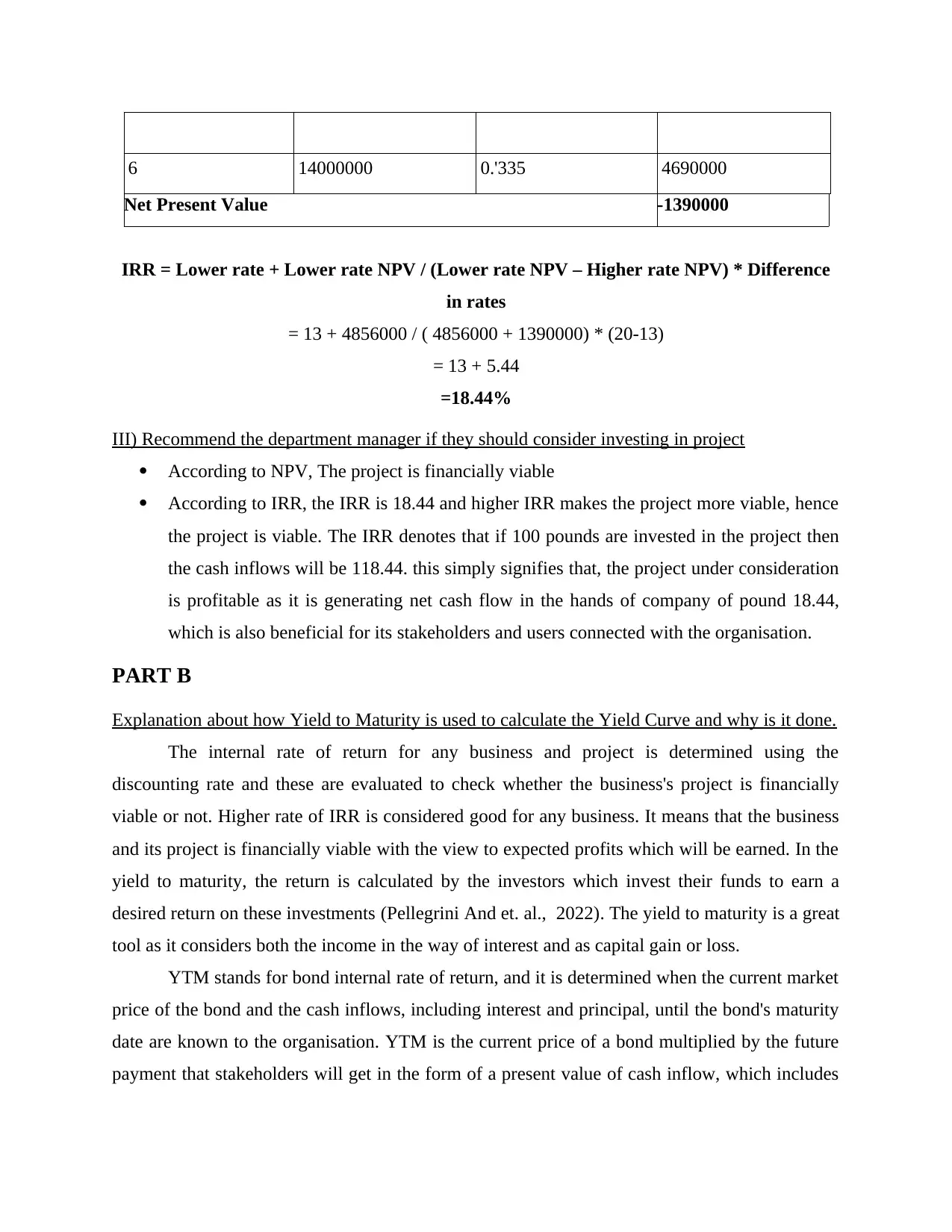
6 14000000 0.'335 4690000
Net Present Value -1390000
IRR = Lower rate + Lower rate NPV / (Lower rate NPV – Higher rate NPV) * Difference
in rates
= 13 + 4856000 / ( 4856000 + 1390000) * (20-13)
= 13 + 5.44
=18.44%
III) Recommend the department manager if they should consider investing in project
According to NPV, The project is financially viable
According to IRR, the IRR is 18.44 and higher IRR makes the project more viable, hence
the project is viable. The IRR denotes that if 100 pounds are invested in the project then
the cash inflows will be 118.44. this simply signifies that, the project under consideration
is profitable as it is generating net cash flow in the hands of company of pound 18.44,
which is also beneficial for its stakeholders and users connected with the organisation.
PART B
Explanation about how Yield to Maturity is used to calculate the Yield Curve and why is it done.
The internal rate of return for any business and project is determined using the
discounting rate and these are evaluated to check whether the business's project is financially
viable or not. Higher rate of IRR is considered good for any business. It means that the business
and its project is financially viable with the view to expected profits which will be earned. In the
yield to maturity, the return is calculated by the investors which invest their funds to earn a
desired return on these investments (Pellegrini And et. al., 2022). The yield to maturity is a great
tool as it considers both the income in the way of interest and as capital gain or loss.
YTM stands for bond internal rate of return, and it is determined when the current market
price of the bond and the cash inflows, including interest and principal, until the bond's maturity
date are known to the organisation. YTM is the current price of a bond multiplied by the future
payment that stakeholders will get in the form of a present value of cash inflow, which includes
Net Present Value -1390000
IRR = Lower rate + Lower rate NPV / (Lower rate NPV – Higher rate NPV) * Difference
in rates
= 13 + 4856000 / ( 4856000 + 1390000) * (20-13)
= 13 + 5.44
=18.44%
III) Recommend the department manager if they should consider investing in project
According to NPV, The project is financially viable
According to IRR, the IRR is 18.44 and higher IRR makes the project more viable, hence
the project is viable. The IRR denotes that if 100 pounds are invested in the project then
the cash inflows will be 118.44. this simply signifies that, the project under consideration
is profitable as it is generating net cash flow in the hands of company of pound 18.44,
which is also beneficial for its stakeholders and users connected with the organisation.
PART B
Explanation about how Yield to Maturity is used to calculate the Yield Curve and why is it done.
The internal rate of return for any business and project is determined using the
discounting rate and these are evaluated to check whether the business's project is financially
viable or not. Higher rate of IRR is considered good for any business. It means that the business
and its project is financially viable with the view to expected profits which will be earned. In the
yield to maturity, the return is calculated by the investors which invest their funds to earn a
desired return on these investments (Pellegrini And et. al., 2022). The yield to maturity is a great
tool as it considers both the income in the way of interest and as capital gain or loss.
YTM stands for bond internal rate of return, and it is determined when the current market
price of the bond and the cash inflows, including interest and principal, until the bond's maturity
date are known to the organisation. YTM is the current price of a bond multiplied by the future
payment that stakeholders will get in the form of a present value of cash inflow, which includes
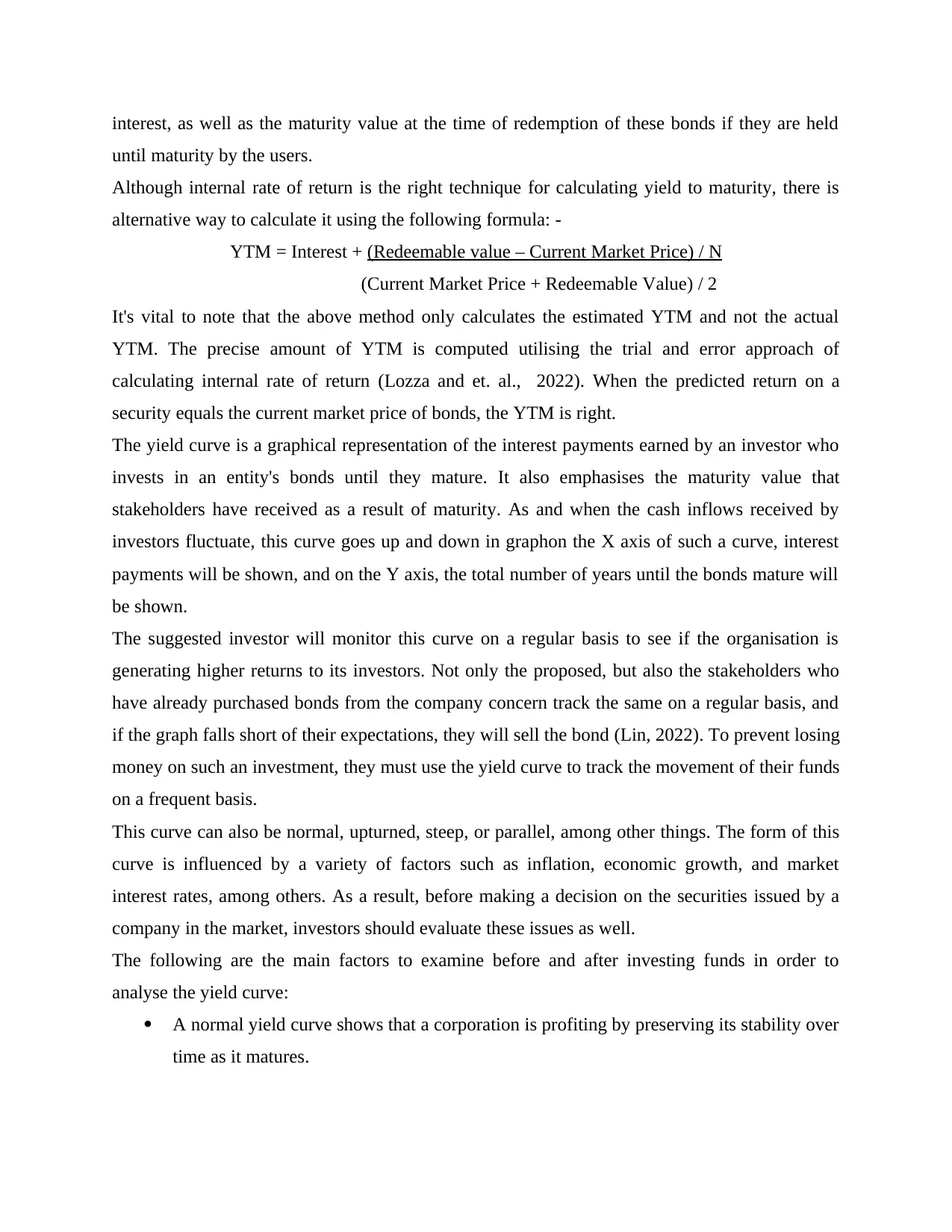
interest, as well as the maturity value at the time of redemption of these bonds if they are held
until maturity by the users.
Although internal rate of return is the right technique for calculating yield to maturity, there is
alternative way to calculate it using the following formula: -
YTM = Interest + (Redeemable value – Current Market Price) / N
(Current Market Price + Redeemable Value) / 2
It's vital to note that the above method only calculates the estimated YTM and not the actual
YTM. The precise amount of YTM is computed utilising the trial and error approach of
calculating internal rate of return (Lozza and et. al., 2022). When the predicted return on a
security equals the current market price of bonds, the YTM is right.
The yield curve is a graphical representation of the interest payments earned by an investor who
invests in an entity's bonds until they mature. It also emphasises the maturity value that
stakeholders have received as a result of maturity. As and when the cash inflows received by
investors fluctuate, this curve goes up and down in graphon the X axis of such a curve, interest
payments will be shown, and on the Y axis, the total number of years until the bonds mature will
be shown.
The suggested investor will monitor this curve on a regular basis to see if the organisation is
generating higher returns to its investors. Not only the proposed, but also the stakeholders who
have already purchased bonds from the company concern track the same on a regular basis, and
if the graph falls short of their expectations, they will sell the bond (Lin, 2022). To prevent losing
money on such an investment, they must use the yield curve to track the movement of their funds
on a frequent basis.
This curve can also be normal, upturned, steep, or parallel, among other things. The form of this
curve is influenced by a variety of factors such as inflation, economic growth, and market
interest rates, among others. As a result, before making a decision on the securities issued by a
company in the market, investors should evaluate these issues as well.
The following are the main factors to examine before and after investing funds in order to
analyse the yield curve:
A normal yield curve shows that a corporation is profiting by preserving its stability over
time as it matures.
until maturity by the users.
Although internal rate of return is the right technique for calculating yield to maturity, there is
alternative way to calculate it using the following formula: -
YTM = Interest + (Redeemable value – Current Market Price) / N
(Current Market Price + Redeemable Value) / 2
It's vital to note that the above method only calculates the estimated YTM and not the actual
YTM. The precise amount of YTM is computed utilising the trial and error approach of
calculating internal rate of return (Lozza and et. al., 2022). When the predicted return on a
security equals the current market price of bonds, the YTM is right.
The yield curve is a graphical representation of the interest payments earned by an investor who
invests in an entity's bonds until they mature. It also emphasises the maturity value that
stakeholders have received as a result of maturity. As and when the cash inflows received by
investors fluctuate, this curve goes up and down in graphon the X axis of such a curve, interest
payments will be shown, and on the Y axis, the total number of years until the bonds mature will
be shown.
The suggested investor will monitor this curve on a regular basis to see if the organisation is
generating higher returns to its investors. Not only the proposed, but also the stakeholders who
have already purchased bonds from the company concern track the same on a regular basis, and
if the graph falls short of their expectations, they will sell the bond (Lin, 2022). To prevent losing
money on such an investment, they must use the yield curve to track the movement of their funds
on a frequent basis.
This curve can also be normal, upturned, steep, or parallel, among other things. The form of this
curve is influenced by a variety of factors such as inflation, economic growth, and market
interest rates, among others. As a result, before making a decision on the securities issued by a
company in the market, investors should evaluate these issues as well.
The following are the main factors to examine before and after investing funds in order to
analyse the yield curve:
A normal yield curve shows that a corporation is profiting by preserving its stability over
time as it matures.
⊘ This is a preview!⊘
Do you want full access?
Subscribe today to unlock all pages.

Trusted by 1+ million students worldwide

From the beginning, the yield curve on the upper side implies that the organisation is
developing at a faster rate (Kaur, 2022).
A downward yield curve shows that company is failing to match investors' expectations
for short- and long-term bonds.
A flat yield curve implies that the company is not offering more value to its customers,
for example.
PART C
Critical Analysis of the statement 'Financial Intermediaries are vital to a well-functioning
financial system.'
Financial Intermediary refers to an individual, group of individuals or an organisation which is a
middleman between two or more bodies which are making a financial transaction. These may
include, commercial banks, investment banks, mutual fund and pension fund. These
intermediaries provide the clients with variety of benefits like financial safety, liquidity etc. these
intermediaries serve as a middleman for the transactions that take place between different
financial institutions and their clients (Garzik, 2022). These help the users of financial markets to
have an efficient deal and lower the different costs of the transactions. They make the risks
lower, provide economies of scale and reduce the costs.
The financial intermediaries make the excess funds mobile. They help in transferring the
funds from parties who have excess of them and parties which require the funds for different
growth aspects. In a financial system, the intermediaries that help in its functioning. These are in
important source for the big companies and start-ups of external funding. They borrow goods
from the lenders and individuals who want to safeguard their assets and further lend these excess
funds to the companies. Mainly, it’s the banks who play the role of intermediaries in a financial
setting. There are two types of intermediaries which are, asset based financial intermediaries like
the banks and fee based financial intermediaries like the brokers which provide portfolio
management.
The financial intermediaries have to play a central role in the financial market to ensure
efficient allocation of the resources. The main advantage of having financial intermediaries are
as follows:
developing at a faster rate (Kaur, 2022).
A downward yield curve shows that company is failing to match investors' expectations
for short- and long-term bonds.
A flat yield curve implies that the company is not offering more value to its customers,
for example.
PART C
Critical Analysis of the statement 'Financial Intermediaries are vital to a well-functioning
financial system.'
Financial Intermediary refers to an individual, group of individuals or an organisation which is a
middleman between two or more bodies which are making a financial transaction. These may
include, commercial banks, investment banks, mutual fund and pension fund. These
intermediaries provide the clients with variety of benefits like financial safety, liquidity etc. these
intermediaries serve as a middleman for the transactions that take place between different
financial institutions and their clients (Garzik, 2022). These help the users of financial markets to
have an efficient deal and lower the different costs of the transactions. They make the risks
lower, provide economies of scale and reduce the costs.
The financial intermediaries make the excess funds mobile. They help in transferring the
funds from parties who have excess of them and parties which require the funds for different
growth aspects. In a financial system, the intermediaries that help in its functioning. These are in
important source for the big companies and start-ups of external funding. They borrow goods
from the lenders and individuals who want to safeguard their assets and further lend these excess
funds to the companies. Mainly, it’s the banks who play the role of intermediaries in a financial
setting. There are two types of intermediaries which are, asset based financial intermediaries like
the banks and fee based financial intermediaries like the brokers which provide portfolio
management.
The financial intermediaries have to play a central role in the financial market to ensure
efficient allocation of the resources. The main advantage of having financial intermediaries are
as follows:
Paraphrase This Document
Need a fresh take? Get an instant paraphrase of this document with our AI Paraphraser

Maturity transformation: Financial intermediaries provide long term funds to the
borrowers meanwhile ensuring that the depositors manage the liquidity. This is due to the
fact that different investors, invest their funds for short term and long term.
Value Transformation: These intermediaries help in combining different small deposits
from varied investors and lend large amount of money with the pooling of the funds.
Expertise: These individuals have detailed and specialist knowledge about the risk
management and foreseeing the profitability of the projects which the lenders and
borrowers may planning to take (Fourie and Bennett, 2022).
Reduction in transaction costs: These reduce the transaction cost by acting as a source
between the borrowers and lenders.
Ease of borrowing: The borrowers in any economy may find it easy as they do not have
to approach different lenders and may go to any one financial intermediary.
These financial intermediaries may be looked as a good option as they allow lenders and
borrowers to connect, they also have some major disadvantages. These disadvantages are as
follows:
Low Returns on Investment: The financial intermediaries that work in the financial
system have the aim to earn a profit and to reduce their in-hand costs, they tend to
provide low rate of interest to the investors and usually take a little higher rate of interest
from its depositors.
Fees and Commissions: The institutions and individuals of the business chare fees and
commissions on the assistance that they provide to the investors and the borrowers in the
financial setting. These fees and commissions are generally charged on the basis of the
amount of funds that are being under transaction.
Opposing Goals: The objective of the intermediaries and the investors have a clash as
they are working to attain different objectives (Duncan, 2022). Due to this reason the
objective of any one of the parties may not be met and hence there might be a sense of
frustration due to same.
False opportunities: the different financial intermediaries in the financial setting may
bring or formulate different investment opportunities which ensures that the returns to the
investors will be maximum having some hidden risks. The yield from this investment
borrowers meanwhile ensuring that the depositors manage the liquidity. This is due to the
fact that different investors, invest their funds for short term and long term.
Value Transformation: These intermediaries help in combining different small deposits
from varied investors and lend large amount of money with the pooling of the funds.
Expertise: These individuals have detailed and specialist knowledge about the risk
management and foreseeing the profitability of the projects which the lenders and
borrowers may planning to take (Fourie and Bennett, 2022).
Reduction in transaction costs: These reduce the transaction cost by acting as a source
between the borrowers and lenders.
Ease of borrowing: The borrowers in any economy may find it easy as they do not have
to approach different lenders and may go to any one financial intermediary.
These financial intermediaries may be looked as a good option as they allow lenders and
borrowers to connect, they also have some major disadvantages. These disadvantages are as
follows:
Low Returns on Investment: The financial intermediaries that work in the financial
system have the aim to earn a profit and to reduce their in-hand costs, they tend to
provide low rate of interest to the investors and usually take a little higher rate of interest
from its depositors.
Fees and Commissions: The institutions and individuals of the business chare fees and
commissions on the assistance that they provide to the investors and the borrowers in the
financial setting. These fees and commissions are generally charged on the basis of the
amount of funds that are being under transaction.
Opposing Goals: The objective of the intermediaries and the investors have a clash as
they are working to attain different objectives (Duncan, 2022). Due to this reason the
objective of any one of the parties may not be met and hence there might be a sense of
frustration due to same.
False opportunities: the different financial intermediaries in the financial setting may
bring or formulate different investment opportunities which ensures that the returns to the
investors will be maximum having some hidden risks. The yield from this investment

may not be promised and can turn out as a failure and investor might face losses of their
financial funds.
High Interest on Loans: The financial intermediaries in the financial setting charge a
high rate of interest on the loan which they provide to the borrowers. This interest rate is
considered as income of the business and they focus on converting this income into the
profits for their own organisation.
In a financial setting of an organisation, there are different types of financial intermediaries
present which have different purpose to work as in intermediary between the investors and the
borrowers. These different intermediaries are discussed below:
1. Banks: These are the well-known financial intermediary in an economy. They are the
central and the commercial banks which provide different services to the varied customers.
2. Credit Unions: these are the cooperative sector financial institutions which act as the
middleman between the lenders and the borrowers but their scope is limited to its members.
3. Non-banking finance companies: These institutions are engaged in the activities which
provide loans to the clients of the business at a huge rate of interest (Dhanda, 2022).
4. Stock Exchange: This is one of the markets in financial market where trading is done for
the financial stock of the companies which are mentioned in the stock exchanges. These trading
activities are charged with brokerage.
5. Mutual Fund Companies: These organisations collect amount from various investors
with investment objectives which are identical and have the ability to take risks associated with
investment. These funds are further invested mutually in securities, bonds and other options and
give a capital gain in the long run.
6. Insurance companies: These provide insurance to the individuals against the different
risks related to accident, crash, death and other uncertainties that might occur in the lifetime.
They collect premium as an expense to provide security and the insured person can claim these
funds in any case of mishappening.
7. Financial Advisers or brokers: The financial advisors and the brokers make contract with
the investors and take their funds to invest in the different securities and bonds while providing
guidance to the investors on their invested funds (Del Gaudio and et. al., 2022).
8. Investment Bankers: They provide their services in the Initial public offerings (IPO),
merging and acquisitions etc.
financial funds.
High Interest on Loans: The financial intermediaries in the financial setting charge a
high rate of interest on the loan which they provide to the borrowers. This interest rate is
considered as income of the business and they focus on converting this income into the
profits for their own organisation.
In a financial setting of an organisation, there are different types of financial intermediaries
present which have different purpose to work as in intermediary between the investors and the
borrowers. These different intermediaries are discussed below:
1. Banks: These are the well-known financial intermediary in an economy. They are the
central and the commercial banks which provide different services to the varied customers.
2. Credit Unions: these are the cooperative sector financial institutions which act as the
middleman between the lenders and the borrowers but their scope is limited to its members.
3. Non-banking finance companies: These institutions are engaged in the activities which
provide loans to the clients of the business at a huge rate of interest (Dhanda, 2022).
4. Stock Exchange: This is one of the markets in financial market where trading is done for
the financial stock of the companies which are mentioned in the stock exchanges. These trading
activities are charged with brokerage.
5. Mutual Fund Companies: These organisations collect amount from various investors
with investment objectives which are identical and have the ability to take risks associated with
investment. These funds are further invested mutually in securities, bonds and other options and
give a capital gain in the long run.
6. Insurance companies: These provide insurance to the individuals against the different
risks related to accident, crash, death and other uncertainties that might occur in the lifetime.
They collect premium as an expense to provide security and the insured person can claim these
funds in any case of mishappening.
7. Financial Advisers or brokers: The financial advisors and the brokers make contract with
the investors and take their funds to invest in the different securities and bonds while providing
guidance to the investors on their invested funds (Del Gaudio and et. al., 2022).
8. Investment Bankers: They provide their services in the Initial public offerings (IPO),
merging and acquisitions etc.
⊘ This is a preview!⊘
Do you want full access?
Subscribe today to unlock all pages.

Trusted by 1+ million students worldwide

9. Escrow companies: They come to act as an intermediary to get the different loan
conditions fulfilled by one party for the real estate mortgage.
10. Collective Investment Schemes: The different investors which have a common
investment objective come together to combine their funds and invest them in a major profitable
option.
PART D
Discussion related to the factors which determine the time-lag between the application of
instrument or tool of monetary policy and the achievement of the ultimate goal.
The transmission mechanism of monetary policy refers to the process with which the price level
in an economy and the general rates are affected (Cline and Mazumder, 2022). This process is
long and it is dynamic having uncertain time lags. Hence, it is hard for the economist to predict
the effect of the monetary policy on the economy. This transmission process affects the monetary
policy of the business and the economic growth, prices and other aspects.
Action of the Central Bank:
National banks from one side of the planet to the other have comparative objectives.
Value security is the essential objective of national banks, albeit low joblessness and long haul
financial development are often key objectives also.
National banks can utilize an assortment of money related approach instruments to
accomplish their goals, including loan costs, quantitative facilitating/fixing, hold prerequisites,
and premium on saves.
The effects of financial arrangement on the economy may not be promptly evident,
especially assuming that the idea of cash impartiality is maintained. The endeavours of national
banks to attempt to impact the economy, then again, infer that national investor feel that,
basically in the close to term, financial approach can impact the economy rather than only
expansion levels.
The most well-known instrument utilized by national banks to affect the economy is the
official interest rate (Clavero, 2022). We'll take a gander at the money related transmission
instrument essentially from the perspective of the authority loan fee.
Market rates, assumptions, resource costs, and trade rates are viewed as the four roads
through which changes in the authority loan fee are proliferated to the economy.
conditions fulfilled by one party for the real estate mortgage.
10. Collective Investment Schemes: The different investors which have a common
investment objective come together to combine their funds and invest them in a major profitable
option.
PART D
Discussion related to the factors which determine the time-lag between the application of
instrument or tool of monetary policy and the achievement of the ultimate goal.
The transmission mechanism of monetary policy refers to the process with which the price level
in an economy and the general rates are affected (Cline and Mazumder, 2022). This process is
long and it is dynamic having uncertain time lags. Hence, it is hard for the economist to predict
the effect of the monetary policy on the economy. This transmission process affects the monetary
policy of the business and the economic growth, prices and other aspects.
Action of the Central Bank:
National banks from one side of the planet to the other have comparative objectives.
Value security is the essential objective of national banks, albeit low joblessness and long haul
financial development are often key objectives also.
National banks can utilize an assortment of money related approach instruments to
accomplish their goals, including loan costs, quantitative facilitating/fixing, hold prerequisites,
and premium on saves.
The effects of financial arrangement on the economy may not be promptly evident,
especially assuming that the idea of cash impartiality is maintained. The endeavours of national
banks to attempt to impact the economy, then again, infer that national investor feel that,
basically in the close to term, financial approach can impact the economy rather than only
expansion levels.
The most well-known instrument utilized by national banks to affect the economy is the
official interest rate (Clavero, 2022). We'll take a gander at the money related transmission
instrument essentially from the perspective of the authority loan fee.
Market rates, assumptions, resource costs, and trade rates are viewed as the four roads
through which changes in the authority loan fee are proliferated to the economy.
Paraphrase This Document
Need a fresh take? Get an instant paraphrase of this document with our AI Paraphraser
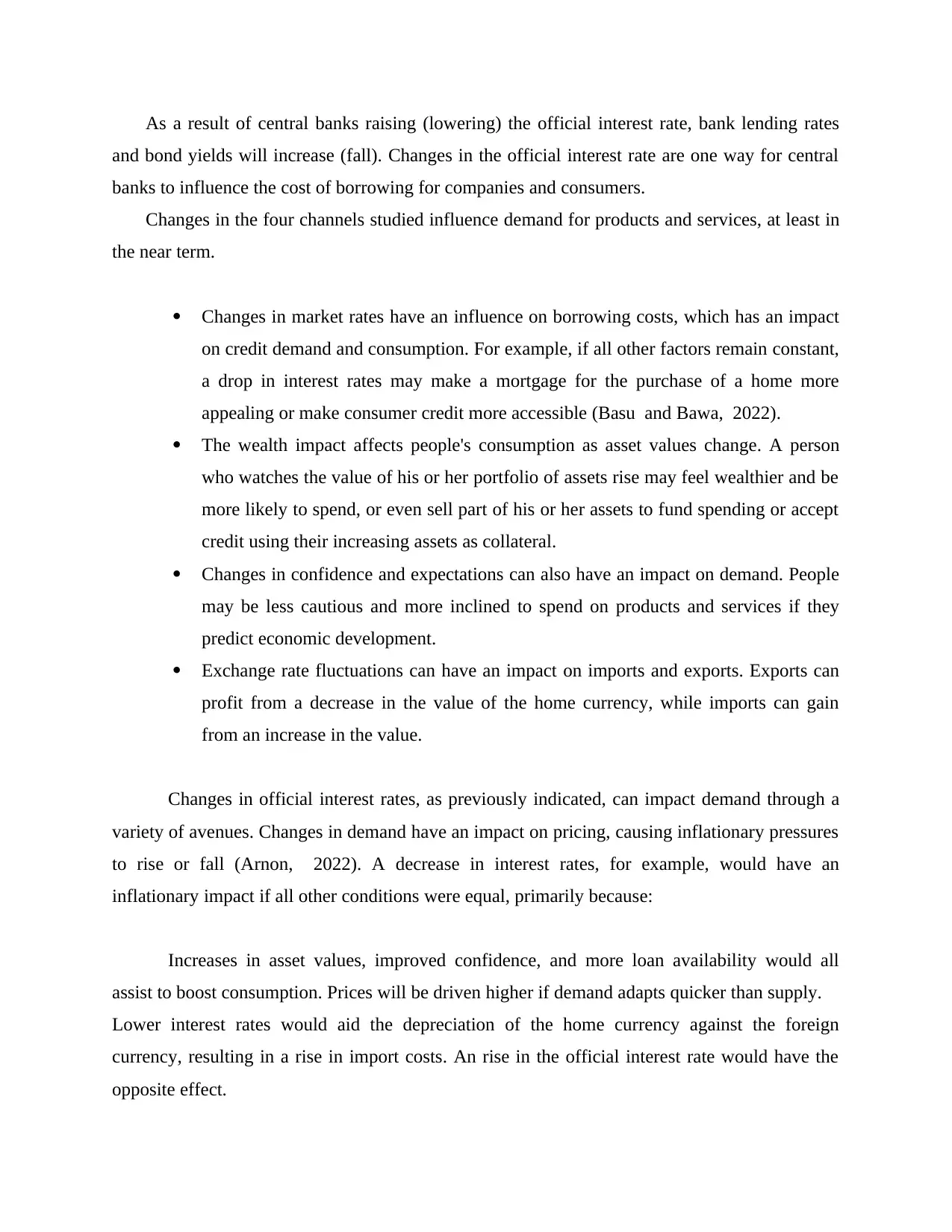
As a result of central banks raising (lowering) the official interest rate, bank lending rates
and bond yields will increase (fall). Changes in the official interest rate are one way for central
banks to influence the cost of borrowing for companies and consumers.
Changes in the four channels studied influence demand for products and services, at least in
the near term.
Changes in market rates have an influence on borrowing costs, which has an impact
on credit demand and consumption. For example, if all other factors remain constant,
a drop in interest rates may make a mortgage for the purchase of a home more
appealing or make consumer credit more accessible (Basu and Bawa, 2022).
The wealth impact affects people's consumption as asset values change. A person
who watches the value of his or her portfolio of assets rise may feel wealthier and be
more likely to spend, or even sell part of his or her assets to fund spending or accept
credit using their increasing assets as collateral.
Changes in confidence and expectations can also have an impact on demand. People
may be less cautious and more inclined to spend on products and services if they
predict economic development.
Exchange rate fluctuations can have an impact on imports and exports. Exports can
profit from a decrease in the value of the home currency, while imports can gain
from an increase in the value.
Changes in official interest rates, as previously indicated, can impact demand through a
variety of avenues. Changes in demand have an impact on pricing, causing inflationary pressures
to rise or fall (Arnon, 2022). A decrease in interest rates, for example, would have an
inflationary impact if all other conditions were equal, primarily because:
Increases in asset values, improved confidence, and more loan availability would all
assist to boost consumption. Prices will be driven higher if demand adapts quicker than supply.
Lower interest rates would aid the depreciation of the home currency against the foreign
currency, resulting in a rise in import costs. An rise in the official interest rate would have the
opposite effect.
and bond yields will increase (fall). Changes in the official interest rate are one way for central
banks to influence the cost of borrowing for companies and consumers.
Changes in the four channels studied influence demand for products and services, at least in
the near term.
Changes in market rates have an influence on borrowing costs, which has an impact
on credit demand and consumption. For example, if all other factors remain constant,
a drop in interest rates may make a mortgage for the purchase of a home more
appealing or make consumer credit more accessible (Basu and Bawa, 2022).
The wealth impact affects people's consumption as asset values change. A person
who watches the value of his or her portfolio of assets rise may feel wealthier and be
more likely to spend, or even sell part of his or her assets to fund spending or accept
credit using their increasing assets as collateral.
Changes in confidence and expectations can also have an impact on demand. People
may be less cautious and more inclined to spend on products and services if they
predict economic development.
Exchange rate fluctuations can have an impact on imports and exports. Exports can
profit from a decrease in the value of the home currency, while imports can gain
from an increase in the value.
Changes in official interest rates, as previously indicated, can impact demand through a
variety of avenues. Changes in demand have an impact on pricing, causing inflationary pressures
to rise or fall (Arnon, 2022). A decrease in interest rates, for example, would have an
inflationary impact if all other conditions were equal, primarily because:
Increases in asset values, improved confidence, and more loan availability would all
assist to boost consumption. Prices will be driven higher if demand adapts quicker than supply.
Lower interest rates would aid the depreciation of the home currency against the foreign
currency, resulting in a rise in import costs. An rise in the official interest rate would have the
opposite effect.
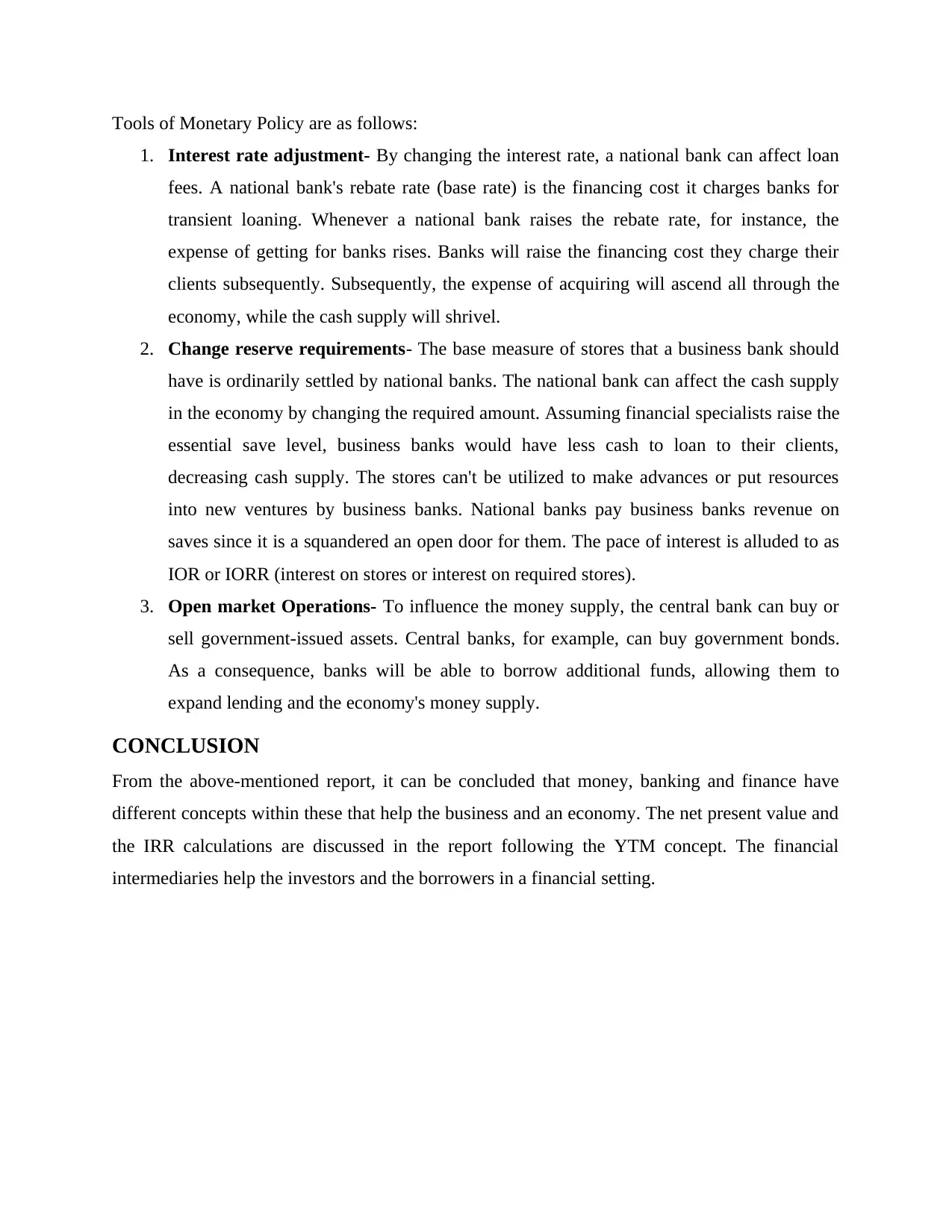
Tools of Monetary Policy are as follows:
1. Interest rate adjustment- By changing the interest rate, a national bank can affect loan
fees. A national bank's rebate rate (base rate) is the financing cost it charges banks for
transient loaning. Whenever a national bank raises the rebate rate, for instance, the
expense of getting for banks rises. Banks will raise the financing cost they charge their
clients subsequently. Subsequently, the expense of acquiring will ascend all through the
economy, while the cash supply will shrivel.
2. Change reserve requirements- The base measure of stores that a business bank should
have is ordinarily settled by national banks. The national bank can affect the cash supply
in the economy by changing the required amount. Assuming financial specialists raise the
essential save level, business banks would have less cash to loan to their clients,
decreasing cash supply. The stores can't be utilized to make advances or put resources
into new ventures by business banks. National banks pay business banks revenue on
saves since it is a squandered an open door for them. The pace of interest is alluded to as
IOR or IORR (interest on stores or interest on required stores).
3. Open market Operations- To influence the money supply, the central bank can buy or
sell government-issued assets. Central banks, for example, can buy government bonds.
As a consequence, banks will be able to borrow additional funds, allowing them to
expand lending and the economy's money supply.
CONCLUSION
From the above-mentioned report, it can be concluded that money, banking and finance have
different concepts within these that help the business and an economy. The net present value and
the IRR calculations are discussed in the report following the YTM concept. The financial
intermediaries help the investors and the borrowers in a financial setting.
1. Interest rate adjustment- By changing the interest rate, a national bank can affect loan
fees. A national bank's rebate rate (base rate) is the financing cost it charges banks for
transient loaning. Whenever a national bank raises the rebate rate, for instance, the
expense of getting for banks rises. Banks will raise the financing cost they charge their
clients subsequently. Subsequently, the expense of acquiring will ascend all through the
economy, while the cash supply will shrivel.
2. Change reserve requirements- The base measure of stores that a business bank should
have is ordinarily settled by national banks. The national bank can affect the cash supply
in the economy by changing the required amount. Assuming financial specialists raise the
essential save level, business banks would have less cash to loan to their clients,
decreasing cash supply. The stores can't be utilized to make advances or put resources
into new ventures by business banks. National banks pay business banks revenue on
saves since it is a squandered an open door for them. The pace of interest is alluded to as
IOR or IORR (interest on stores or interest on required stores).
3. Open market Operations- To influence the money supply, the central bank can buy or
sell government-issued assets. Central banks, for example, can buy government bonds.
As a consequence, banks will be able to borrow additional funds, allowing them to
expand lending and the economy's money supply.
CONCLUSION
From the above-mentioned report, it can be concluded that money, banking and finance have
different concepts within these that help the business and an economy. The net present value and
the IRR calculations are discussed in the report following the YTM concept. The financial
intermediaries help the investors and the borrowers in a financial setting.
⊘ This is a preview!⊘
Do you want full access?
Subscribe today to unlock all pages.

Trusted by 1+ million students worldwide
1 out of 14
Related Documents
Your All-in-One AI-Powered Toolkit for Academic Success.
+13062052269
info@desklib.com
Available 24*7 on WhatsApp / Email
![[object Object]](/_next/static/media/star-bottom.7253800d.svg)
Unlock your academic potential
Copyright © 2020–2025 A2Z Services. All Rights Reserved. Developed and managed by ZUCOL.





